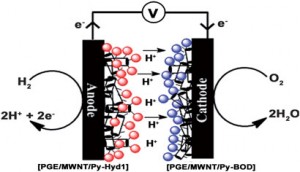A hydrogen fuel cell that uses carbon nanotubes to increase the amount of electrocatalyst attached to electrodes has been designed by UK scientists. This arrangement offers an order of magnitude improvement in power density over existing designs, they say.
Membrane-less hydrogen fuel cells based on enzyme electrocatalysts offer a clean and sustainable source of energy. In contrast to conventional hydrogen fuel cells, the high specificity of enzyme active sites means they can work on a mixed feed of hydrogen and oxidant so they don’t require protons transported across a membrane; however, fuel cells depend on the performance of their electrocatalysts and enzymes are bulky, which limits the power output.

The fuel cell features two enzymes as electrocatalysts on specially modified electrodes – an oxygen-tolerant hydrogenase for the anode and bilirubin oxidase for the cathode
Read the full story in Chemistry World
Link to journal Article
Order-of-Magnitude Enhancement of an Enzymatic Hydrogen-Air Fuel Cell based on Pyrenyl Carbon Nanostructures
Fraser A Armstrong and Sadagopan Krishnan
Chem. Sci., 2012, Accepted Manuscript, DOI: 10.1039/C2SC01103D










